display FORD FIESTA 2007 Workshop Manual
[x] Cancel search | Manufacturer: FORD, Model Year: 2007, Model line: FIESTA, Model: FORD FIESTA 2007Pages: 1226, PDF Size: 61.26 MB
Page 22 of 1226
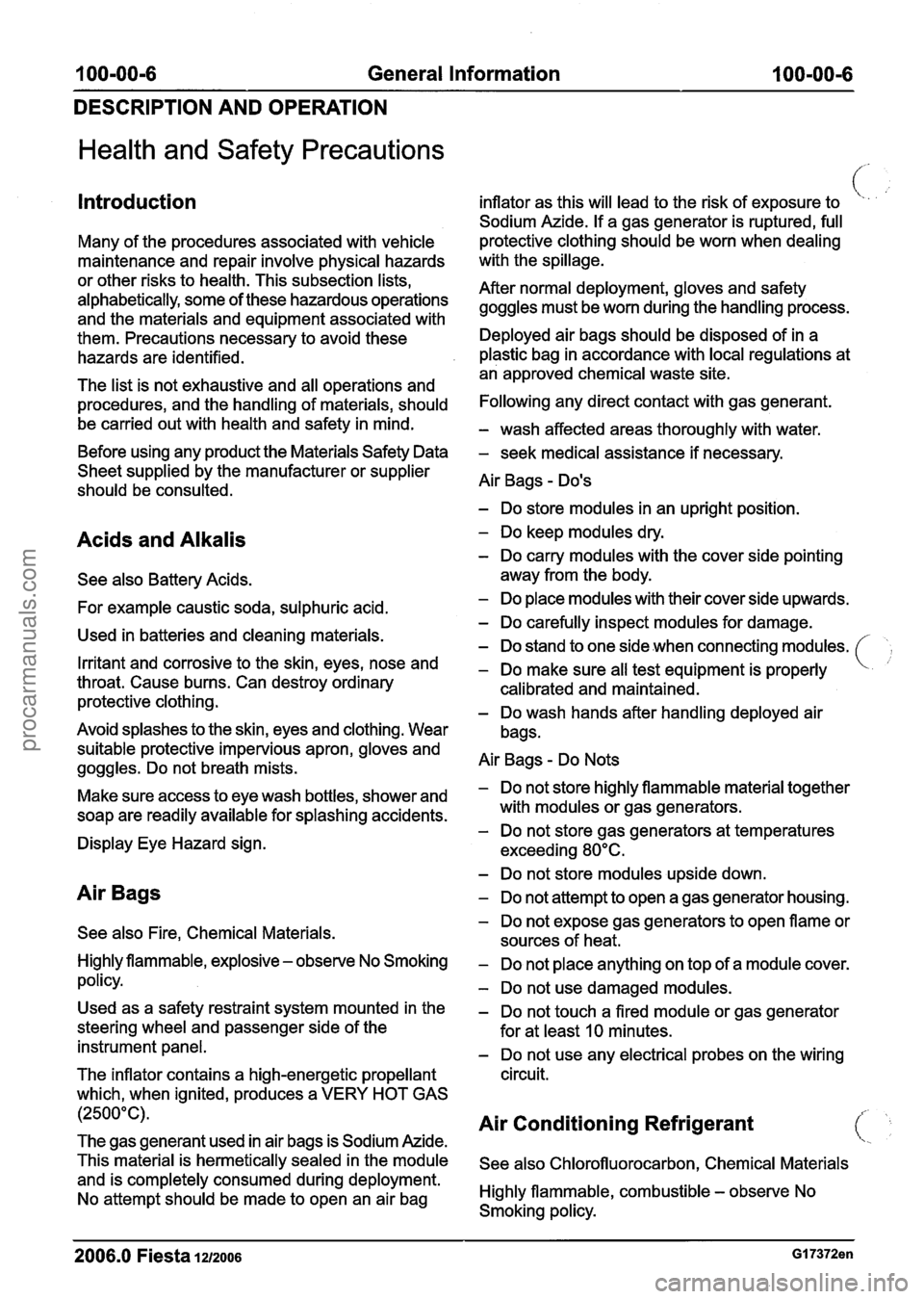
100-00-6 General Information 100-00-6
DESCRIPTION AND OPERATION
Health and Safety Precautions
Introduction
Many of the procedures associated with vehicle
maintenance and repair involve physical hazards
or other risks to health. This subsection lists,
alphabetically, some of these hazardous operations
and the materials and equipment associated with
them. Precautions necessary to avoid these
hazards are identified.
The list is not exhaustive and all operations and
procedures, and the handling of materials, should
be carried out with health and safety in mind.
Before using any product the Materials Safety Data
Sheet supplied by the manufacturer or supplier
should be consulted.
Acids and Alkalis
See also Battery Acids.
For example caustic soda, sulphuric acid.
Used in batteries and cleaning materials.
Irritant and corrosive to the skin, eyes, nose and
throat. Cause burns. Can destroy ordinary
protective clothing.
Avoid splashes to the skin, eyes and clothing. Wear
suitable protective impervious apron, gloves and
goggles. Do not breath mists.
Make sure access to eye wash bottles, shower and
soap are readily available for splashing accidents.
Display Eye Hazard sign.
Air Bags
See also Fire, Chemical Materials.
Highly flammable, explosive
- observe No Smoking
policy.
Used as a safety restraint system mounted in the
steering wheel and passenger side of the instrument panel.
The inflator contains a high-energetic propellant
which, when ignited, produces a VERY HOT GAS
(2500°C).
The gas
generant used in air bags is Sodium Azide.
This material is hermetically sealed in the module
and is completely consumed during deployment.
No attempt should be made to open an air bag inflator
as this will lead to the risk of exposure to
( '.
Sodium Azide. If a gas generator is ruptured, full
protective clothing should be worn when dealing
with the spillage.
After normal deployment, gloves and safety goggles must be worn during the handling process.
Deployed air bags should be disposed of in a
plastic bag in accordance with local regulations at
an approved chemical waste site.
Following any direct contact with gas generant.
- wash affected areas thoroughly with water.
- seek medical assistance if necessary.
Air Bags
- Do's
- Do store modules in an upright position.
- Do keep modules dry.
- Do carry modules with the cover side pointing
away from the body.
- Do place modules with their cover side upwards.
- Do carefully inspect modules for damage.
- Do stand to one side when connecting modules.
- Do make sure all test equipment is properly
calibrated and maintained.
- Do wash hands after handling deployed air
bags.
Air Bags
- Do Nots
- Do not store highly flammable material together
with modules or gas generators.
- Do not store gas generators at temperatures
exceeding 80°C.
- Do not store modules upside down.
- Do not attempt to open a gas generator housing.
- Do not expose gas generators to open flame or
sources of heat.
- Do not place anything on top of a module cover.
- Do not use damaged modules.
- Do not touch a fired module or gas generator
for at least
10 minutes.
- Do not use any electrical probes on the wiring
circuit.
Air Conditioning Refrigerant (1,
See also Chlorofluorocarbon, Chemical Materials
Highly flammable, combustible
- observe No
Smoking policy.
2006.0 Fiesta iu200s GI 7372en
procarmanuals.com
Page 33 of 1226
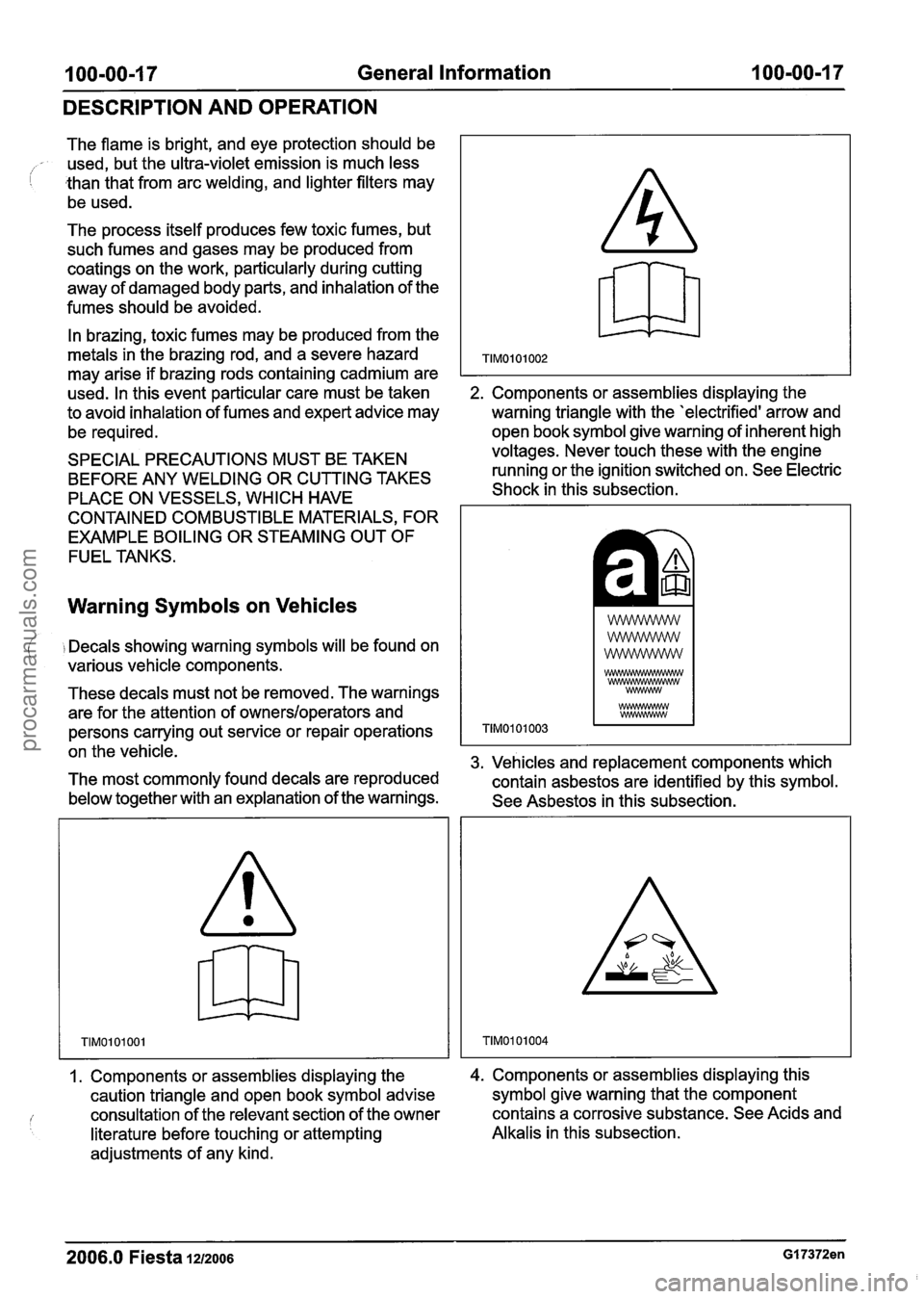
100-00-1 7 General Information 100-00-1 7
DESCRIPTION AND OPERATION
The flame is bright, and eye protection should be - used, but the ultra-violet emission is much less
than that from arc welding, and lighter filters may
be used.
The process itself produces few toxic fumes, but
such fumes and gases may be produced from
coatings on the work, particularly during cutting
away of damaged body parts, and inhalation of the
fumes should be avoided.
In brazing, toxic fumes may be produced from the
metals in the brazing rod, and a severe hazard
may arise if brazing rods containing cadmium are
used. In this event particular care must be taken
2. Components or assemblies displaying the
to avoid inhalation of fumes and expert advice may
warning triangle with the 'electrified' arrow and
be required. open book symbol
give warning of inherent high
SPECIAL PRECAUTIONS MUST BE TAKEN voltages.
Never touch these with the engine
BEFORE ANY WELDING OR CUTTING TAKES running
or the ignition switched on. See Electric
PLACE ON VESSELS, WHICH HAVE Shock
in this subsection.
CONTAINED COMBUSTIBLE MATERIALS, FOR
EXAMPLE BOILING OR STEAMING OUT OF
FUEL TANKS.
Warning Symbols on Vehicles
( i Decals showing warning symbols will be found on
various vehicle components.
These decals must not be removed. The warnings
are for the attention of
owners/operators and
persons carrying out service or repair operations
on the vehicle.
3. Vehicles and replacement components which
The most commonly found decals are reproduced
contain asbestos are identified by this symbol.
below together with an explanation of the warnings.
See Asbestos in this subsection.
1. Components or assemblies displaying the
caution triangle and open book symbol advise
consultation of the relevant section of the owner
literature before touching or attempting
adjustments of any kind. 4. Components or assemblies displaying this
symbol give warning that the component
contains a corrosive substance. See Acids and
Alkalis in this subsection.
2006.0 Fiesta 1212006 GI 7372en
procarmanuals.com
Page 34 of 1226
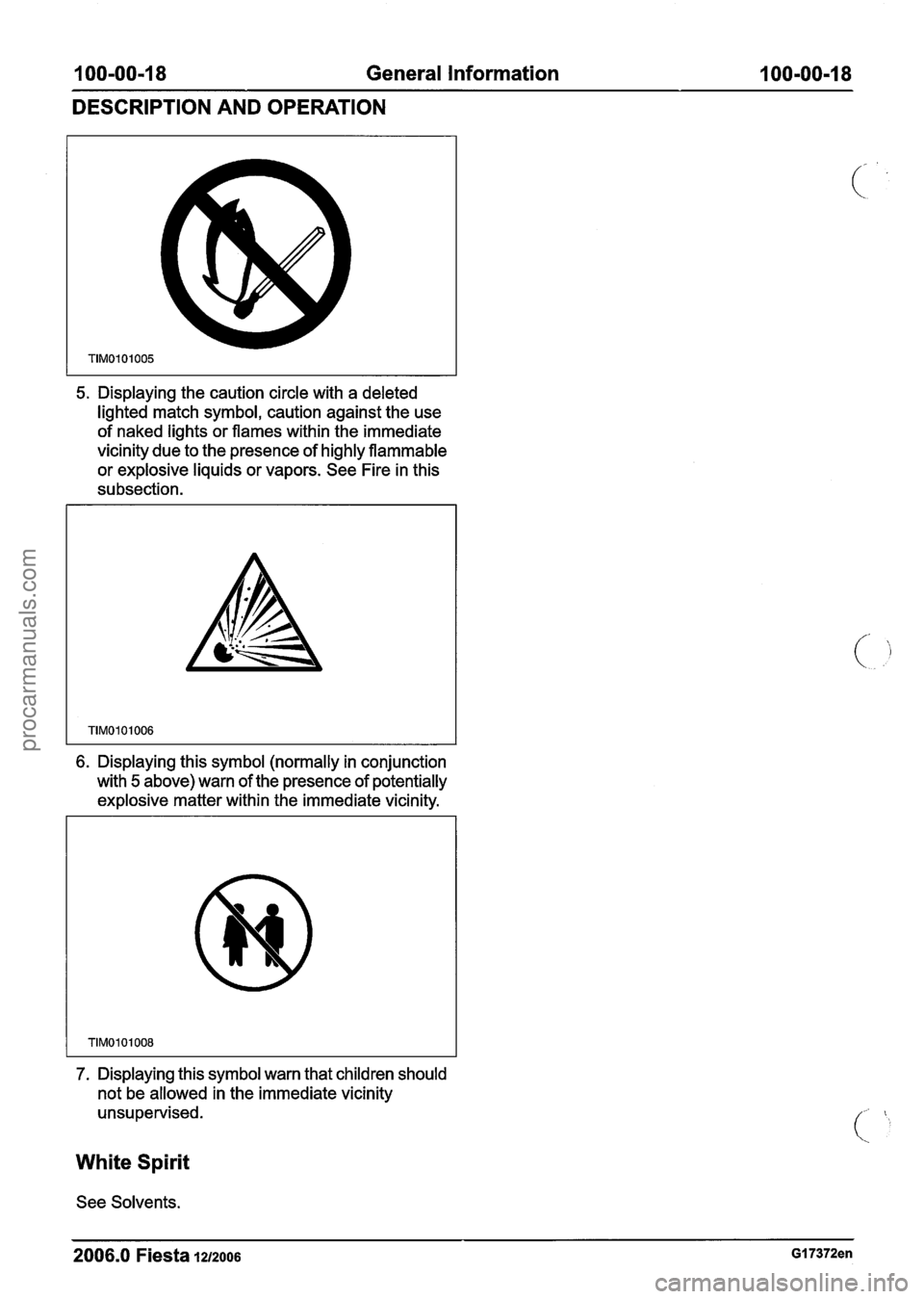
100=00=18 General Information I OO=OO-18
DESCRIPTION AND OPERATION
5. Displaying the caution circle with a deleted
lighted match symbol, caution against the use
of naked lights or flames within the immediate
vicinity due to the presence of highly flammable
or explosive liquids or vapors. See Fire in this
subsection.
6. Displaying this symbol (normally in conjunction
with
5 above) warn of the presence of potentially
explosive matter within the immediate vicinity.
7. Displaying this symbol warn that children should
not be allowed in the immediate vicinity
unsupervised.
White Spirit
See Solvents.
2006.0 Fiesta 1212006 GI 7372en
procarmanuals.com
Page 58 of 1226
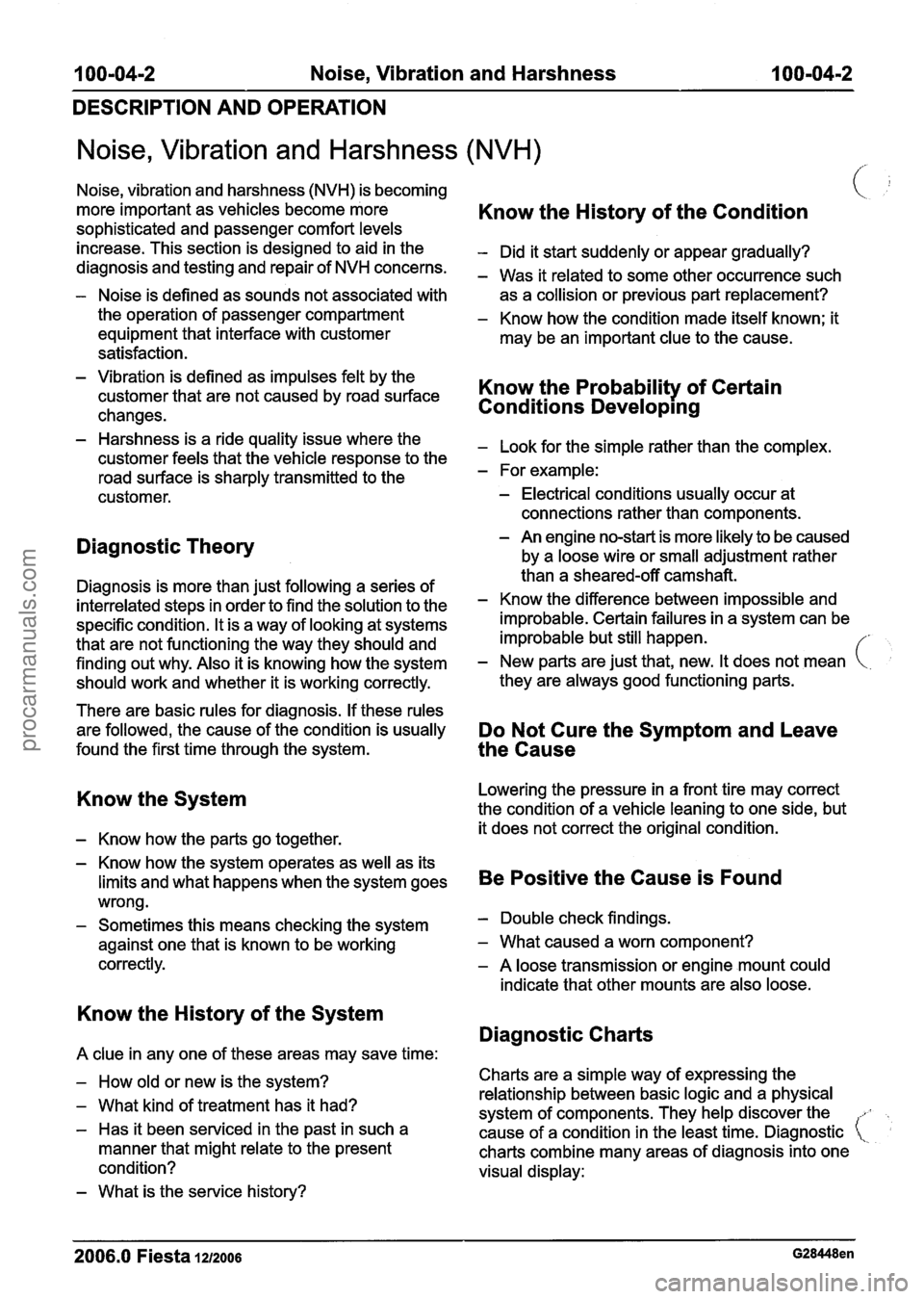
100-04-2 Noise, Vibration and Harshness 100-04-2
DESCRIPTION AND OPERATION
Noise, Vibration and Harshness (NVH)
Noise, vibration and harshness (NVH) is becoming
more important as vehicles become more '
Know the History of the Condition
sophisticated and passenger comfort levels
increase. This section is designed to aid in the
- Did it start suddenly or appear gradually?
diagnosis and testing and repair of NVH concerns.
- Was it related to some other occurrence such
- Noise is defined as sounds not associated with
as a collision or previous part replacement?
the operation of passenger compartment
- Know how the condition made itself known; it
equipment that interface with customer
may be an important clue to the cause.
satisfaction.
- Vibration is defined as impulses felt by the
customer that are not caused by road surface Know the Probability of Certain
changes. Conditions Develop~ng
- Harshness is a ride quality issue where the - Look for the simple rather than the complex.
customer feels that the vehicle response to the
road surface is sharply transmitted to the
- For example:
customer.
- Electrical conditions usually occur at
connections rather than components.
Diagnostic Theory - An engine no-start is more likely to be caused
by a loose wire or small adjustment rather
than a sheared-off
camshafi. Diagnosis is more than just following a series of
interrelated steps in order to find the solution to the - Know the difference between impossible and
specific condition. It is a way of looking at systems improbable. Certain failures
in a system can be
that are not functioning the way they should and improbable
but still happen.
finding out why. Also it is knowing how the system
- New parts are just that, new. It does not mean
should work and whether it is working correctly. they are always
good functioning parts.
There are basic rules for diagnosis. If these rules
are followed, the cause of the condition is usually
Do Not Cure the Symptom and Leave
found the first time through the system. the Cause
Know the System
- Know how the parts go together. Lowering
the pressure in a front tire may correct
the condition of a vehicle leaning to one side, but
it does not correct the original condition.
- Know how the system operates as well as its
limits and what happens when the system goes
Be Positive the Cause is Found
wrong.
- Sometimes this means checking the system - Double check findings.
against one that is known to be working
- What caused a worn component?
correctly.
- A loose transmission or engine mount could
indicate that other mounts are also loose.
Know the History of the System
Diagnostic Charts
A clue in any one of these areas may save time:
- How old or new is the system? Charts are a simple
way of expressing the
relationship between basic logic and a physical
- What kind of treatment has it had?
system of components. They help discover the ,.
- Has it been serviced in the past in such a
cause of a condition in the least time. Diagnostic (,-
manner that might relate to the present
charts combine many areas of diagnosis into one
condition? visual display:
- What is the service history?
2006.0 Fiesta 12/2006 G28448en
procarmanuals.com
Page 759 of 1226
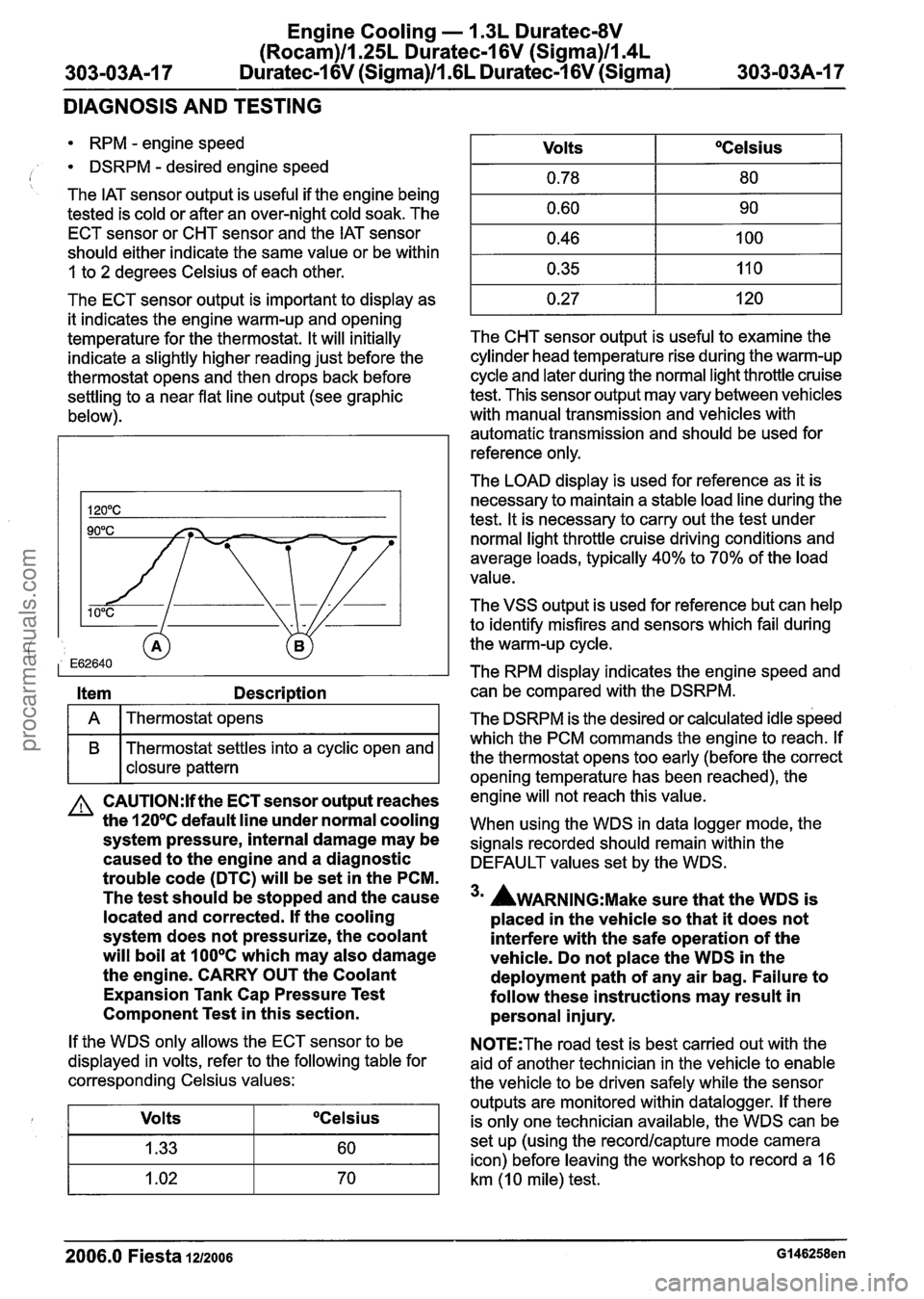
Engine Cooling - I .3L Duratec-8V
(Rocam)llm25L Duratec-1 6V (Sigma)ll.4L
303-03A-17 Duratec-1 6V (Sigma)/lm6L Duratec-1 6V (Sigma) 303-03A-17
DIAGNOSIS AND TESTING
RPM - engine speed
i DSRPM - desired engine speed
The IAT sensor output is useful if the engine being
tested is cold or after an over-night cold soak. The
ECT sensor or CHT sensor and the IAT sensor
should either indicate the same value or be within
1 to 2 degrees Celsius of each other.
The ECT sensor output is important to display as
it indicates the engine warm-up and opening
temperature for the thermostat. It will initially
indicate a slightly higher reading just before the
thermostat opens and then drops back before
settling to a near flat line output (see graphic
below).
Item Description
I A I Thermostat opens I
B Thermostat settles into a cyclic open and
I I closure pattern
A CAUTI0N:lf the ECT sensor output reaches
the
120°C default line under normal cooling
system pressure, internal damage may be
caused to the engine and a diagnostic
trouble code (DTC) will be set in the PCM.
The test should be stopped and the cause
located and corrected. If the cooling
system does not pressurize, the coolant
will boil at
100°C which may also damage
the engine. CARRY OUT the Coolant
Expansion Tank Cap Pressure Test
Component Test in this section.
If the WDS only allows the ECT sensor to be
displayed in volts, refer to the following table for
corresponding Celsius values:
Volts
OCelsius
The CHT sensor output is useful to examine the
cylinder head temperature rise during the warm-up
cycle and later during the normal light throttle cruise
test. This sensor output may vary between vehicles
with manual transmission and vehicles with
automatic transmission and should be used for
reference only.
Volts
0.78
0.60
0.46
0.35
0.27
The
LOAD display is used for reference as it is
necessary to maintain a stable load line during the
test. It is necessary to carry out the test under
normal light throttle cruise driving conditions and
average loads, typically
40% to 70% of the load
value.
OCelsius
80
90
100
11 0
120
The VSS output is used for reference but can help
to identify misfires and sensors which fail during
the warm-up cycle.
The RPM display indicates the engine speed and can be compared with the DSRPM.
The DSRPM is the desired or calculated idle speed
which the PCM commands the engine to reach. If
the thermostat opens too early (before the correct
opening temperature has been reached), the
engine will not reach this value.
When using the WDS in data logger mode, the
signals recorded should remain within the
DEFAULT values set by the WDS.
3m AWARNING:M~~~ sure that the WDS is
placed in the vehicle so that it does not
interfere with the safe operation of the
vehicle. Do not place the WDS in the
deployment path of any air bag. Failure to
follow these instructions may result in personal injury.
N0TE:The road test is best carried out with the
aid of another technician in the vehicle to enable
the vehicle to be driven safely while the sensor
outputs are monitored within datalogger. If there
is only one technician available, the WDS can be
set up (using the
recordlcapture mode camera
icon) before leaving the workshop to record a
16
km (1 0 mile) test.
2006.0 Fiesta 1212006 GI 46258en
procarmanuals.com
Page 784 of 1226

303-03B-14 Engine Cooling - 2.OL Duratec-HE (M14) 303-03B-14
DIAGNOSIS AND TESTING
4. Observe the cooling system pressure tester make sure the pressure test reading
is
gauge reading for approximately two minutes. repeatable
and within acceptable gauge reading
The pressure should not drop during this time. limits of
the coolant expansion tank cap.
( If the system holds Pressure, proceed to Step 5. If the pressure test gauge readings are not 7. If the system does not hold pressure, check
within the acceptable gauge reading limits,
it thoroughly for coolant leaks.
INSTALL a new coolant expansion tank cap.
5. Check the engine for coolant leaks. Drain the
cooling system, repair any coolant leaks found
and fill and bleed the cooling system as
Thermostat Test
necessaw.
REFER to: Cooling System Draining, Filling and
Bleeding (303-03 Engine Cooling
- 2.OL
Duratec-HE (M14), General Procedures).
.Recheck the system by repeating Steps 3 and
4 at least twice.
Radiator Leak Test, Removed From Vehicle
CAUTI0N:Radiator internal pressure must
not exceed
130 kpa (20 psi) or damage may
result.
Clean the radiator thoroughly before leak testing
it, to prevent contamination of the water in the test
tank. Leak test the radiator in clean water with 138
kpa (20 psi) air pressure. Check it thoroughly for
air leaks. INSTALL a new radiator if necessary.
REFER to: Radiator (303-03 Engine Cooling
- 2.OL
Duratec-HE (M14), Removal and Installation).
Coolant Expansion Tank Cap Pressure Test
A WARNING:When releasing the system
pressure, cover the expansion tank cap
with a thick cloth to prevent the possibility
of coolant scalding, Failure to follow this
instruction may result in personal injury.
1. Remove the coolant expansion tank cap.
2. Use water to clean the area of the rubber seal
and pressure relief valve. Install the pressure
tester and adapter and immerse the coolant
-
expansion tank cap in water.
N0TE:lf the plunger of the pump is depressed too
quickly, an erroneous pressure reading will result.
3. Slowly depress the plunger of the pressure test
pump until the pressure gauge reading stops
increasing, and note the highest pressure
reading obtained.
4. Release pressure by turning the pressure relief
screw counterclockwise. Tighten the pressure
relief screw and repeat step 3 at least twice to
I. Connect the WDS to the data link connector
(DLC).
2. Using the WDS datalogger function, SELECT
the following sensors (as applicable to the
application):
IAT
- intake air temperature (IAT) sensor
ECT
- engine coolant temperature (ECT) sensor
CHT
- cylinder head temperature (CHT) sensor
LOAD
- engine load
VSS
- vehicle speed sensor (VSS)
RPM
- engine speed
DSRPM
- desired engine speed
The IAT sensor output is useful if the engine being
tested is cold or after an over-night cold soak. The
ECT sensor or CHT sensor and the IAT sensor
(
should either indicate the same value or be within
1 to 2 degrees Celsius of each other.
The ECT sensor output is important to display as
it indicates the engine warm-up and opening
temperature for the thermostat. It will initially
indicate a slightly higher reading just before the
thermostat opens and then drops back before
settling to a near flat line output (see graphic
below).
Item Description 1'. .
) A 1 Thermostat opens I\
B Thermostat settles into a cyclic open and
I I closure pattern
2006.0 Fiesta 1212006 G426582en
procarmanuals.com
Page 785 of 1226

303-03B-15 Engine Cooling - 2.OL Duratec-HE (M14) 303-03B-15
DIAGNOSIS AND TESTING
A CAUTI0N:lf the ECT sensor output reaches
the
120°C default line under normal cooling
system pressure, internal damage may be
caused to the engine and a diagnostic
trouble code (DTC) will be set in the PCM.
The test should be stopped and the cause
located and corrected. If the cooling
system does not pressurize, the coolant
will boil at
1 OO°C which may also damage
the engine. CARRY
OUT the Coolant
Expansion Tank Cap Pressure Test
Component Test in this section.
If the WDS only allows the ECT sensor to be
displayed in volts, refer to the following table for
corresponding Celsius values:
The CHT sensor output is useful to examine the
cylinder head temperature rise during the warm-up
cycle and later during the normal light throttle cruise
test. This sensor output may vary between vehicles
with manual transmission and vehicles with automatic transmission and should be used for
reference only.
Volts
1.33
1.02
0.78
0.60
0.46
0.35 0.27
The LOAD display is used for reference as it is
necessary to maintain a stable load line during the
test. It is necessary to carry out the test under
normal light throttle cruise driving conditions and
average loads, typically 40% to 70% of the load
value.
OCelsius
60
70
80
90
100
110
120 '
The VSS output is used for reference but can help
to identify misfires and sensors which fail during
the warm-up cycle.
The RPM display indicates the engine speed and
can be compared with the DSRPM.
The DSRPM is the desired or calculated idle speed
which the PCM commands the engine to reach. If
the thermostat opens too early (before the correct
opening temperature has been reached), the
engine will not reach this value. When
using the WDS in data logger mode, the
signals recorded should remain within the
DEFAULT values set by the WDS.
3m AWARNING:M~~~ sure that the WDS is
placed in the vehicle so that it does not
interfere with the safe operation of the
vehicle. Do not place the WDS in the
deployment path of any air bag. Failure to
follow these instructions may result in personal injury.
N0TE:The road test is best carried out with the
aid of another technician in the vehicle to enable
the vehicle to be driven safely while the sensor
outputs are monitored within datalogger. If there
is only one technician available, the WDS can be
set up (using the
recordlcapture mode camera
icon) before leaving the workshop to record a 16
km (1 0 mile) test.
N0TE:The results from the test are more
conclusive if the engine is cold when the test is
started.
Carry out a road test.
REFER to:
RoadIRoller Testing (1 00-00 General
Information, Description and Operation).
4. Drive the vehicle at a constant throttle opening
and set speed until the ECT value settles into
a shallow rise and fall signal, close to a straight
line. This indicates that the thermostat is
functioning correctly.
N0TE:Some thermostats indicate the
temperature(s) in Celsius and Fahrenheit.
The graphic below shows the location and an
example of the opening temperature
(88OC) and
fully open temperature (1
02OC) of a thermostat.
The graphic below shows an alternative method used to show the opening temperature
(88OC) and
fully open temperature
(112OC) of a thermostat.
2006.0 Fiesta 1212006 G426582en
procarmanuals.com
Page 932 of 1226
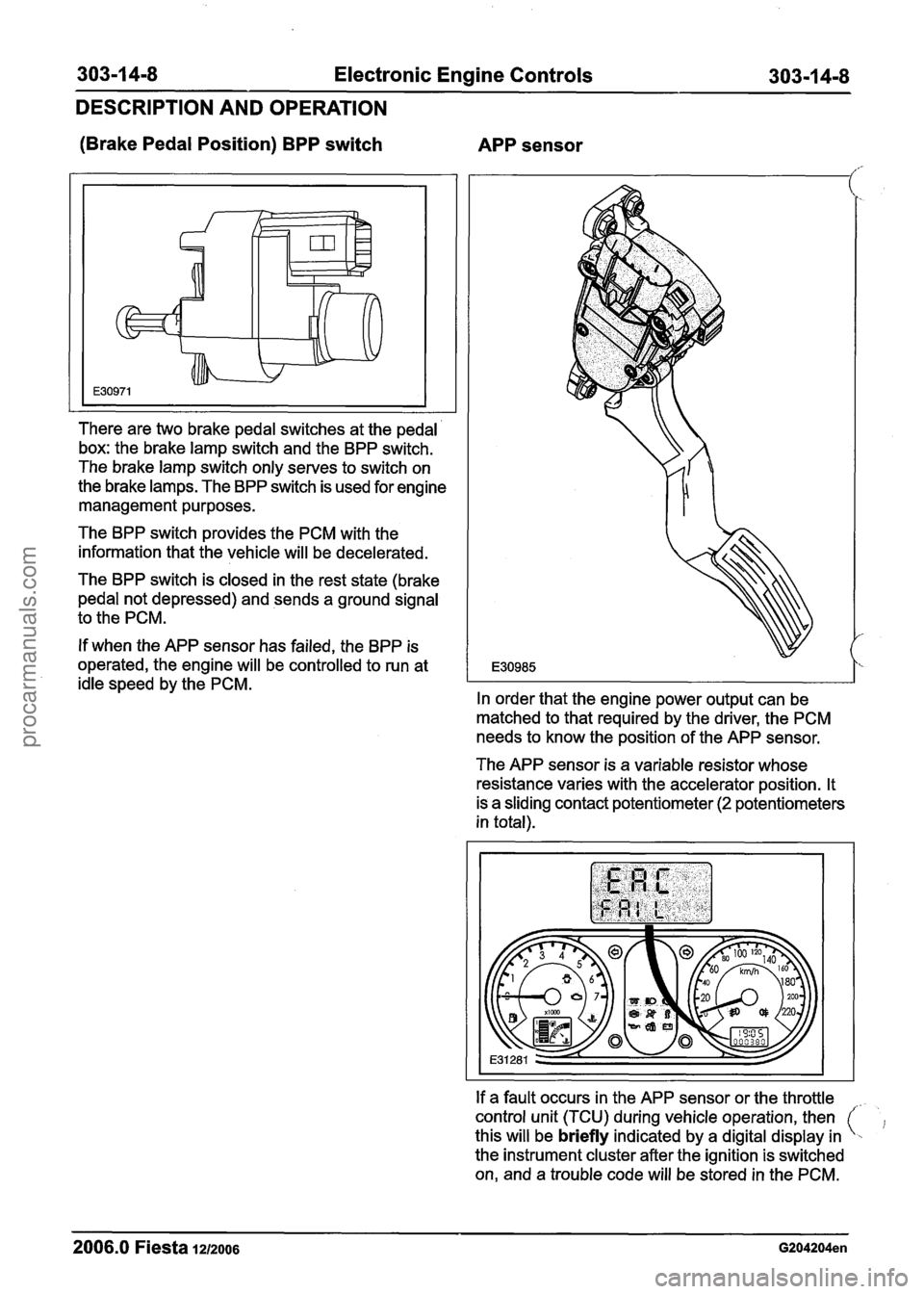
Electronic Engine Controls
DESCRIPTION AND OPERATION
(Brake Pedal Position) BPP switch
APP sensor
There are two brake pedal switches at the pedal
box: the brake lamp switch and the BPP switch.
The brake lamp switch only serves to switch on
the brake lamps. The BPP switch is used for engine
management purposes.
The BPP switch provides the PCM with the
information that the vehicle will be decelerated.
The BPP switch is closed in the rest state (brake
pedal not depressed) and sends a ground signal
to the PCM.
If when the APP sensor has failed, the BPP is
operated, the engine will be controlled to run at
idle speed by the PCM.
In order that the engine power output can be
matched to that required by the driver, the PCM
needs to know the position of the APP sensor.
The APP sensor is a variable resistor whose
resistance varies with the accelerator position. It
is a sliding contact potentiometer
(2 potentiometers
in total).
If a fault occurs in the APP sensor or the throttle
control unit (TCU) during vehicle operation, then
this will be
briefly indicated by a digital display in
the instrument cluster after the ignition is switched
on, and a trouble code will be stored in the PCM.
2006.0 Fiesta 1212006 G204204en
procarmanuals.com
Page 938 of 1226
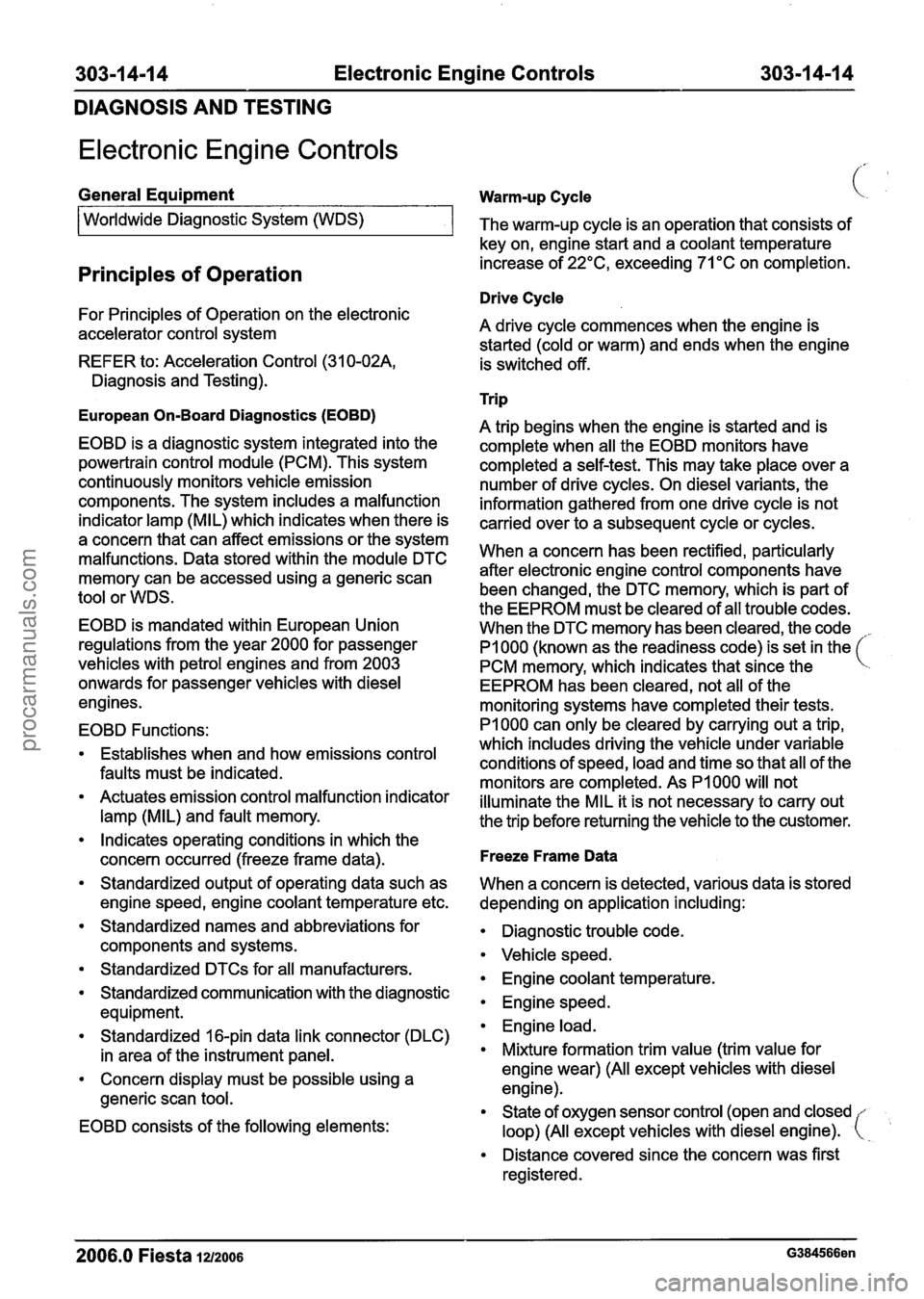
303-1 4-1 4 Electronic Engine Controls 303-1 4-1 4
DIAGNOSIS AND TESTING
Electronic Engine Controls
General Equipment
I Worldwide Diagnostic system (WDS)
Principles of Operation
For Principles of Operation on the electronic
accelerator control system
REFER to: Acceleration Control (31
0-02A,
Diagnosis and Testing).
European On-Board Diagnostics (EOBD)
EOBD is a diagnostic system integrated into the
powertrain control module (PCM). This system
continuously monitors vehicle emission
components. The system includes a malfunction
indicator lamp (MIL) which indicates when there is
a concern that can affect emissions or the system
malfunctions. Data stored within the module DTC
memory can be accessed using a generic scan
tool or WDS.
EOBD is mandated within European Union
regulations from the year 2000 for passenger
vehicles with petrol engines and from 2003 onwards for passenger vehicles with diesel
engines.
EOBD Functions:
Establishes when and how emissions control
faults must be indicated.
Actuates emission control malfunction indicator
lamp (MIL) and fault memory.
Indicates operating conditions in which the
concern occurred (freeze frame data).
Standardized output of operating data such as
engine speed, engine coolant temperature etc.
Standardized names and abbreviations for
components and systems.
Standardized
DTCs for all manufacturers.
Standardized communication with the diagnostic
equipment.
Standardized 16-pin data link connector (DLC)
in area of the instrument panel.
Concern display must be possible using a
generic scan tool.
EOBD consists of the following elements:
Warm-up Cycle C'
The warm-up cycle is an operation that consists of
key on, engine start and a coolant temperature
increase of
22"C, exceeding 71 OC on completion.
Drive Cycle
A drive cycle commences when the engine is
started (cold or warm) and ends when the engine
is switched off.
Trip
A trip begins when the engine is started and is
complete when all the EOBD monitors have
completed a self-test. This may take place over a
number of drive cycles. On diesel variants, the
information gathered from one drive cycle is not
carried over to a subsequent cycle or cycles.
When a concern has been rectified, particularly
after electronic engine control components have
been changed, the DTC memory, which is part of
the EEPROM must be cleared of all trouble codes.
When the DTC memory has been cleared, the code
.
PI000 (known as the readiness code) is set in the
PCM memory, which indicates that since the
EEPROM has been cleared, not all of the
monitoring systems have completed their tests.
PI000 can only be cleared by carrying out a trip,
which includes driving the vehicle under variable
conditions of speed, load and time so that all of the
monitors are completed. As
PI000 will not
illuminate the MIL it is not necessary to carry out
the trip before returning the vehicle to the customer.
Freeze Frame Data
When a concern is detected, various data is stored
depending on application including:
Diagnostic trouble code.
Vehicle speed.
Engine coolant temperature.
Engine speed.
Engine load.
Mixture formation trim value (trim value for
engine wear) (All except vehicles with diesel
engine).
State of oxygen sensor control (open and closed
loop) (All except vehicles with diesel engine).
Distance covered since the concern was first
registered.
2006.0 Fiesta 1212006 G384566en
procarmanuals.com
Page 1219 of 1226
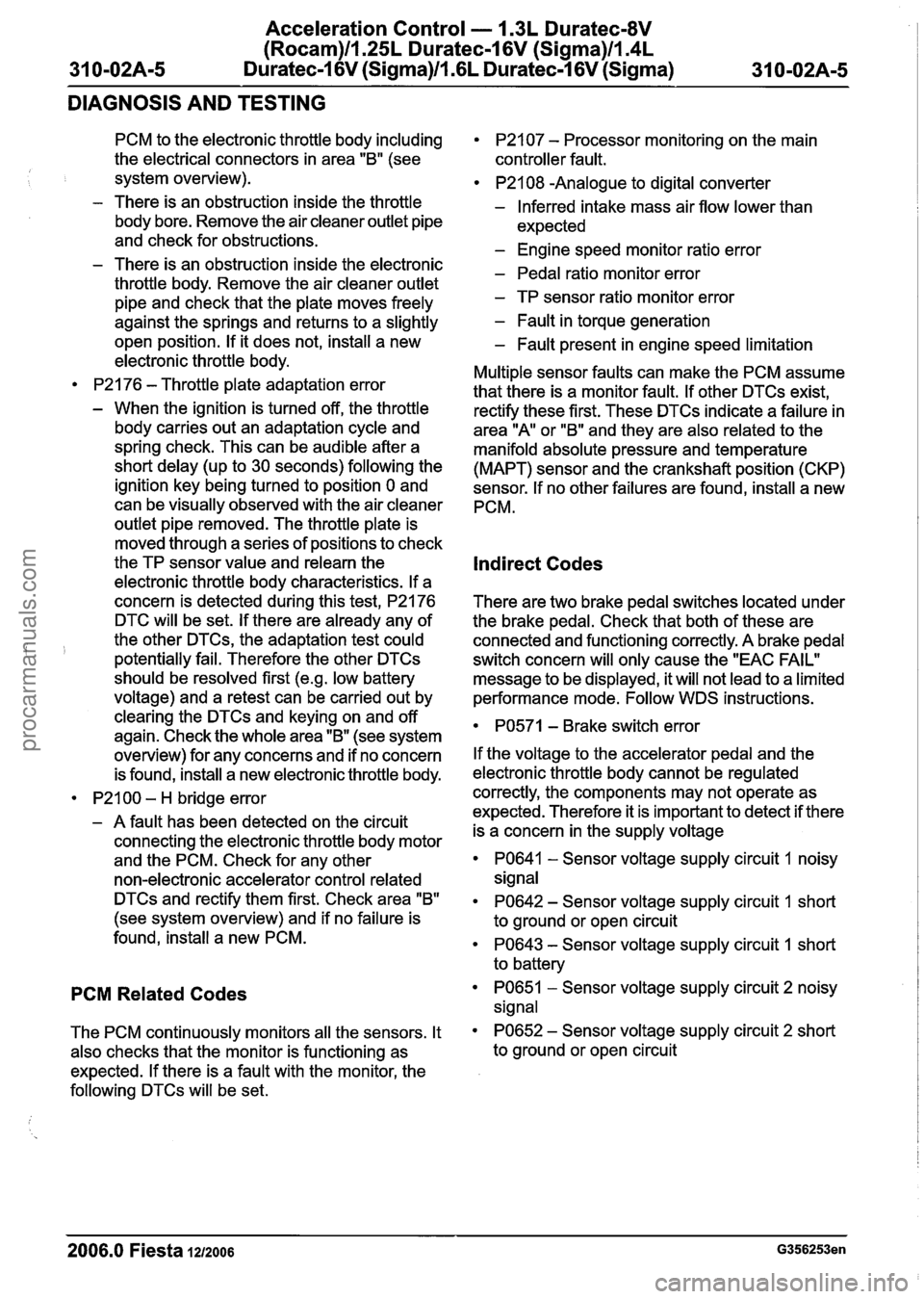
Acceleration Control - 1.3L Duratec-8V
(Rocam)ll.25L Duratec-1 6V (Sigma)ll.4L
31 0-02A-5 Duratec-1 6V (Sigma)/l .6L Duratec-1 6V (Sigma)
31 0-02A-5
DIAGNOSIS AND TESTING
PCM to the electronic throttle body including
the electrical connectors in area "B" (see
system overview).
- There is an obstruction inside the throttle
body bore. Remove the air cleaner outlet pipe
and check for obstructions.
- There is an obstruction inside the electronic
throttle body. Remove the air cleaner outlet
pipe and check that the plate moves freely
against the springs and returns to a slightly
open position. If it does not, install a new
electronic throttle body.
P2176 - Throttle plate adaptation error
- When the ignition is turned off, the throttle
body carries out an adaptation cycle and
spring check. This can be audible after a
short delay (up to 30 seconds) following the ignition key being turned to position
0 and
can be visually observed with the air cleaner
outlet pipe removed. The throttle plate is
moved through a series of positions to check
the TP sensor value and relearn the
electronic throttle body characteristics. If a
concern is detected during this test,
P2176
DTC will be set. If there are already any of
I the other DTCs, the adaptation test could
potentially fail. Therefore the other DTCs
should be resolved first
(e.g. low battery
voltage) and a retest can be carried out by
clearing the DTCs and keying on and off
again. Check the whole area "B" (see system
overview) for any concerns and if no concern
is found, install a new electronic throttle body.
P2100 - H bridge error
- A fault has been detected on the circuit
connecting the electronic throttle body motor
and the PCM. Check for any other
non-electronic accelerator control related
DTCs and rectify them first. Check area "B"
(see system overview) and if no failure is
found, install a new PCM.
PCM Related Codes
The PCM continuously monitors all the sensors. It
also checks that the monitor is functioning as
expected. If there is a fault with the monitor, the
following DTCs will be set.
P2107 - Processor monitoring on the main
controller fault.
P2108 -Analogue to digital converter
- Inferred intake mass air flow lower than
expected
- Engine speed monitor ratio error
- Pedal ratio monitor error
- TP sensor ratio monitor error
- Fault in torque generation
- Fault present in engine speed limitation
Multiple sensor faults can make the PCM assume
that there is a monitor fault. If other DTCs exist,
rectify these first. These DTCs indicate a failure in
area
"A or "B" and they are also related to the
manifold absolute pressure and temperature
(MAPT) sensor and the crankshaft position (CKP)
sensor. If no other failures are found, install a new
PCM.
Indirect Codes
There are two brake pedal switches located under
the brake pedal. Check that both of these are
connected and functioning correctly. A brake pedal
switch concern will only cause the "EAC FAIL"
message to be displayed, it will not lead to a limited
performance mode. Follow WDS instructions.
PO571 - Brake switch error
If the voltage to the accelerator pedal and the
electronic throttle body cannot be regulated
correctly, the components may not operate as
expected. Therefore it is important to detect if there
is a concern in the supply voltage
PO641 - Sensor voltage supply circuit I noisy
signal
PO642 - Sensor voltage supply circuit 1 short
to ground or open circuit
PO643 - Sensor voltage supply circuit 1 short
to battery
PO651 - Sensor voltage supply circuit 2 noisy
signal
PO652 - Sensor voltage supply circuit 2 short
to ground or open circuit
2006.0 Fiesta 1212006 G356253en
procarmanuals.com